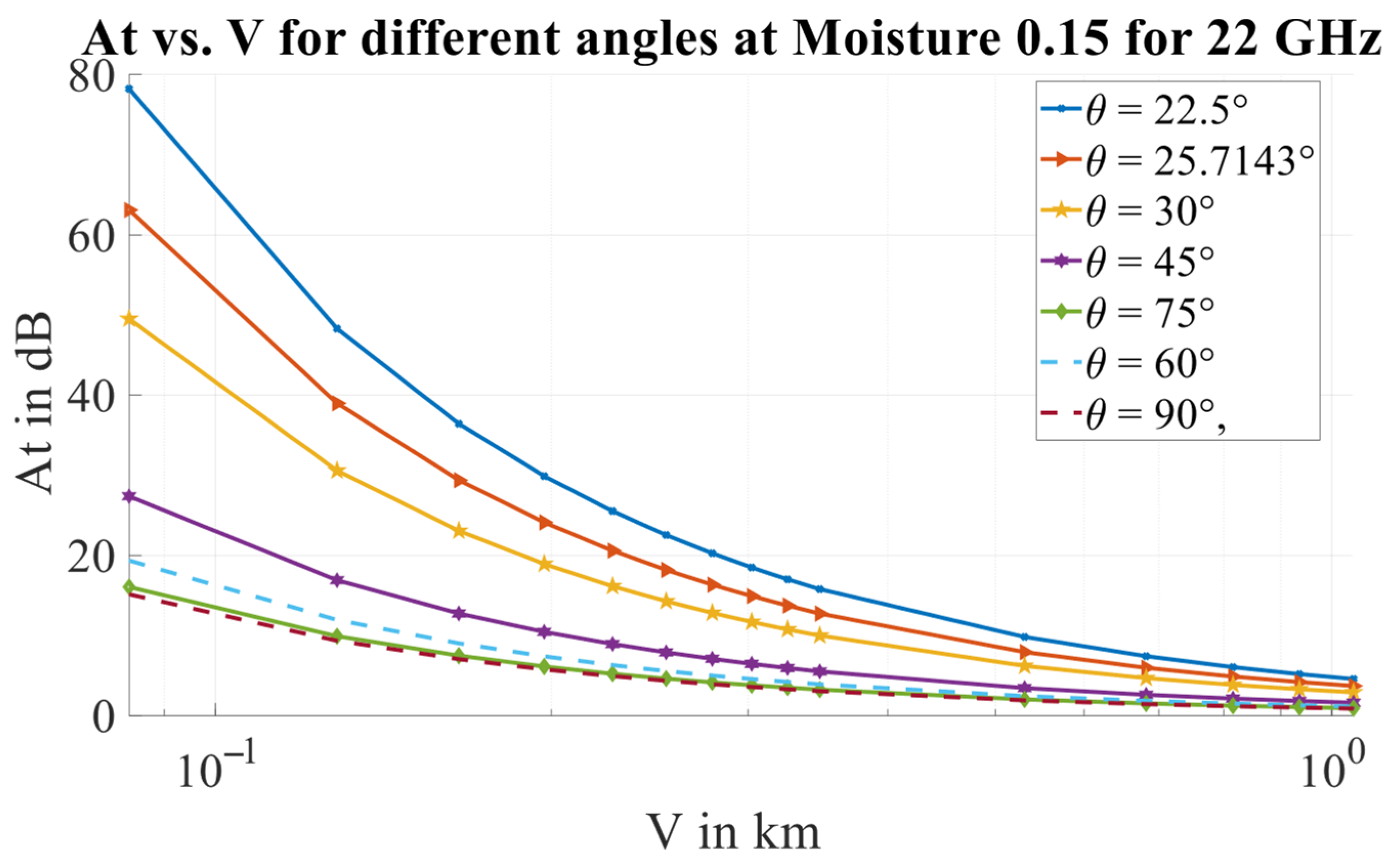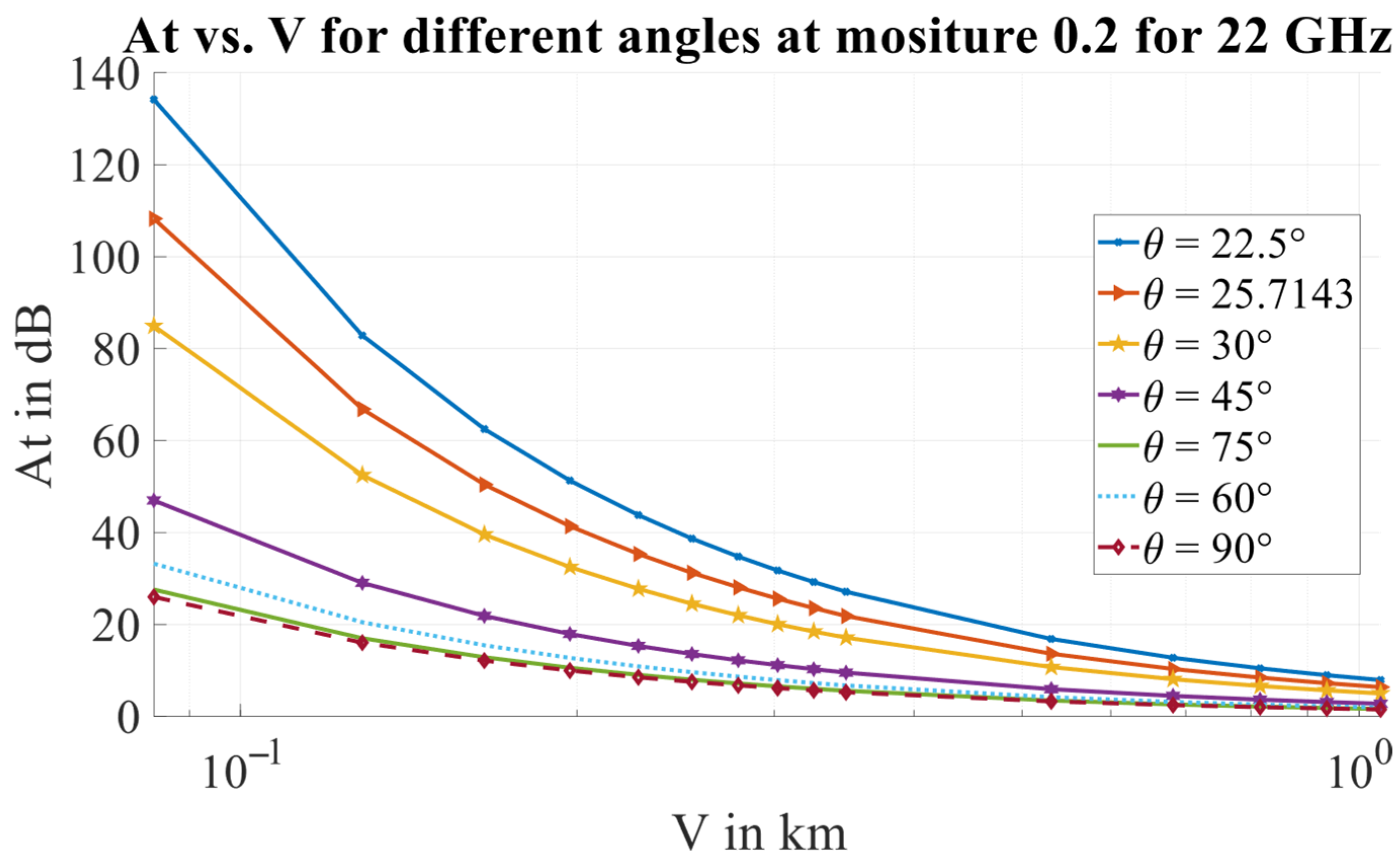Modeling the Effects of Dust Storm Intensity Variations on Earth–Satellite Link
Abstract
1. Introduction
2. Modeling of Dust Storm Nonuniformity
2.1. Development of the Vertical Adjustment Factor
2.2. Effects on Different Heights/Elevation Angles
2.3. Total Attenuation Perdition
3. Attenuation Prediction Using the Proposed Model at 14.4 GHz and 22 GHz
3.1. Predicted Total Attenuation at 14.4 GHz
3.2. Predicted Total Attenuation at 22 GHz
3.3. Applicability to Bent Pipe Multi-Hop Architecture
3.4. Validation of the Proposed Model
4. Conclusions
Funding
Data Availability Statement
Conflicts of Interest
References
- Tirmizi, S.B.R.; Chen, Y.; Lakshminarayana, S.; Feng, W.; Khuwaja, A.A. Hybrid Satellite–Terrestrial Networks toward 6G: Key Technologies and Open Issues. Sensors 2022, 22, 8544. [Google Scholar] [CrossRef]
- Chen, H.-Y.; Ku, C.-C. Calculation of wave attenuation in sand and dust storms by the FDTD and turning bands methods at 10–100 GHz. IEEE Trans. Antennas Propag. 2012, 60, 2951–2960. [Google Scholar] [CrossRef]
- Harb, K.; Omair, B.; Abdul-Jauwad, S.; Al-Yami, A.; Al-Yami, A. A proposed method for dust and sand storms effect on satellite communication networks. In Proceedings of the Innovations on Communication Theory INCT, Istanbul, Turkey, 9–11 May 2012; pp. 33–37. [Google Scholar]
- Gu, Z.; He, Y.; Zhang, Y.; Su, J.; Zhang, R.; Yu, C.W.; Zhang, D. An overview of triggering mechanisms and characteristics of local strong sandstorms in China and haboobs. Atmosphere 2021, 12, 752. [Google Scholar] [CrossRef]
- Musa, A.; Bashir, S.O.; Abdalla, A.H. Review and assessment of electromagnetic wave propagation in sand and dust storms at microwave and millimeter wave bands—Part I. Prog. Electromagn. Res. M 2014, 40, 91–100. [Google Scholar] [CrossRef]
- Musa, A.; Bashir, S.O.; Abdalla, A.H. Review and Assessment of Electromagnetic Wave Propagation in Sand and Dust Storms at Microwave and Millimeter Wave Bands—Part II. Prog. Electromagn. Res. M 2014, 40, 101–110. [Google Scholar] [CrossRef]
- Musa, A.; Paul, B.S. Dust Particles’ Permittivity in Microwave Signal Propagation: A Review. J. Commun. 2020, 15, 38–44. [Google Scholar] [CrossRef]
- Alozie, E.; Musa, A.; Faruk, N.; Imoize, A.L.; Abdulkarim, A.; Usman, A.D.; Imam-Fulani, Y.O.; Adewole, K.S.; Oloyede, A.A.; Sowande, O.A.; et al. A review of dust-induced electromagnetic waves scattering theories and models for 5G and beyond wireless communication systems. Sci. Afr. 2023, 21, e01816. [Google Scholar] [CrossRef]
- Musa, A.; Camara, M.F.; Abdulla, A.H.; Bashir, S.O.; Hamed, S.M.A. Modeling of dust particles canting as input to microwave cross polarization. In Proceedings of the 2015 International Conference on Computing, Control, Networking, Electronics and Embedded Systems Engineering (ICCNEEE), Khartoum, Sudan, 7–9 September 2015; pp. 87–90. [Google Scholar] [CrossRef]
- Afzaal, K.; Bandopadhyaya, T.K.; Poonam, S. Effect of soil textural class and relative humidity of regions in accurate prediction of attenuation of millimeter waves during sand and dust storms. In Proceedings of the Fourth International Kharkov Symposium ‘Physics and Engineering of Millimeter and Sub-Millimeter Waves’. Symposium Proceedings (Cat. No.01EX429), Kharkov, Ukraine, 4–9 June 2001; Volume 1, pp. 393–395. [Google Scholar] [CrossRef]
- Harb, K.; Abdalla, A.T.; Mohamed, M.; Abdul-Jauwad, S. HAPs communication in Saudi Arabia under dusty weather conditions. In Proceedings of the 2013 IEEE 11th Malaysia International Conference on Communications (MICC), Kuala Lumpur, Malaysia, 26–28 November 2013; pp. 379–380. [Google Scholar] [CrossRef]
- Chu, T. BSTJ brief: Effects of sandstorms on microwave propagation. Bell Syst. Tech. J. 1979, 58, 549–555. [Google Scholar] [CrossRef]
- Ahmed, A.S.; Ali, A.A.; Alhaider, M.A. Airborne Dust Size Analysis for Tropospheric Propagation of Millimetric Waves into Dust Storms. Geosci. Remote Sens. IEEE Trans. 1987, GE-25, 593–599. [Google Scholar] [CrossRef]
- Goldhirsh, J. Attenuation and backscatter from a derived two-dimensional duststorm model. Antennas and Propagation. IEEE Trans. 2001, 49, 1703–1711. [Google Scholar] [CrossRef]
- Elabdin, Z.; Islam, M.R.; Khalifa, O.O.; Raouf, H.E.A.; Salami, M.J.E. Development of mathematical model for the prediction of microwave signal attenuation due to duststorm. In Proceedings of the 2008 International Conference on Computer and Communication Engineering, Kuala Lumpur, Malaysia, 13–15 May 2008; pp. 1156–1161. [Google Scholar] [CrossRef]
- Sharif, S.M. Attenuation properties of dusty media using Mie scattering solution. Prog. Electromagn. Res. M 2015, 43, 9–18. [Google Scholar] [CrossRef]
- Elsheikh, E.A.A.; Islam, M.R.; Habaebi, M.H.; Ismail, A.F.; Zyoud, A. Dust Storm Attenuation Modeling Based on Measurements in Sudan. IEEE Trans. Antennas Propag. 2017, 65, 4200–4208. [Google Scholar] [CrossRef]
- Dong, X.-Y.; Chen, H.-Y.; Guo, D.-H. Microwave and millimeter-wave attenuation in sand and dust storms. IEEE Antennas Wirel. Propag. Lett. 2011, 10, 469–471. [Google Scholar] [CrossRef]
- Shamim, M.Z.M.; Elsheikh, E.A.A.; Salih, F.E.M.S.; Islam, M.R. Signal Attenuation Prediction Model for a 22 GHz Terrestrial Communication Link in Sudan Due to Dust and Sand Storms Using Machine Learning. IEEE Access 2021, 9, 164632–164642. [Google Scholar] [CrossRef]
- Harb, K.; Butt, O.; Al-Yami, A.A.; Abdul-Jauwad, S. Probabilistic dust storm layers impacting satellite communications. In Proceedings of the 2013 IEEE International Conference on Space Science and Communication (IconSpace), Melaka, Malaysia, 1–3 July 2013; pp. 407–411. [Google Scholar] [CrossRef]
- Harb, K.; Abdillah, S.; Abdul-Jauwad, S. Dust & sand (DUSA) storms impact on LEO satellite microwave radio links. In Proceedings of the 2014 7th Advanced Satellite Multimedia Systems Conference and the 13th Signal Processing for Space Communications Workshop (ASMS/SPSC), Livorno, Italy, 8–10 September 2014; pp. 442–447. [Google Scholar] [CrossRef]
- Jervase, J.; Sharif, S. Influence of duststorms and reflector tolerance on cross polarization of earth satellite links. In Proceedings of the Arabsat Symposium, Riyadh, Saudi; 1988; pp. 166–169. [Google Scholar]
- Elsheikh, E.A.A.; Islam, M.R.; Al-Khateeb, K.; Alam, A.Z.; Elshaikh, Z.O. A proposed vertical path adjustment factor for dust storm attenuation prediction. In Proceedings of the 2011 4th International Conference on Mechatronics (ICOM), Kuala Lumpur, Malaysia, 17–19 May 2011; pp. 1–3. [Google Scholar] [CrossRef]
- Vishvakarma, B.R.; Rai, C.S. Limitations of Rayleigh scattering in the prediction of millimeter wave attenuation in sand and dust storms. In Proceedings of the IGARSS’93–IEEE International Geoscience and Remote Sensing Symposium, Tokyo, Japan, 18–21 August 1993; Volume 1, pp. 267–269. [Google Scholar] [CrossRef]
- Eltahir, E.I.; Islam, R.; Elsheikh, E.A.A.; Zyoud, A.; Abdalla, A.H.; Habaebi, M.H.; Rahim, S.K.A.; Hamdan, M. Review on Millimeter Wave Propagation Through Sand and Dust Storm—Impact of Humidity. IEEE Access 2025, 13, 149695–149718. [Google Scholar] [CrossRef]
- Harb, K.M.; Mitu, S.S.I.; Ullah, M.; Attia, H. Nonuniform Scattering of Microwave Radiation Due to Layered DUSA Storm: Theory and Experiment. IEEE Can. J. Electr. Comput. Eng. 2021, 44, 384–389. [Google Scholar] [CrossRef]
- Elsheikh, E.A.A.; Rafiqul, I.M.; Habaebi, M.H.; Zyoud, A.; Suliman, F.E.M.; Eltahir, E.I.; Amin, N.W. Effect of Dust Storm Intensity Variations on Total Path Attenuation Prediction. IEEE Trans. Antennas Propag. 2021, 70, 2884–2890. [Google Scholar] [CrossRef]
- Ouyang, Q.; Ye, N.; An, J. On the Vulnerability of Mega-Constellation Networks Under Geographical Failure. IEEE Trans. Netw. 2025, 33, 2049–2062. [Google Scholar] [CrossRef]
- Lee, J.-Y.; Lim, B.; Ko, Y.-C. Performance analysis of multi-hop low earth orbit satellite network over mixed RF/FSO links. ICT Express 2024, 10, 1051–1058. [Google Scholar] [CrossRef]













| Case (V km) | 22 GHz | 14.4 GHz | |
|---|---|---|---|
| Severe (0.0837) | 20.66 dB | 18.20 dB | 38.85 dB |
| Moderate (0.3022) | 4.42 dB | 3.84 dB | 8.26 dB |
| Light (1.046) | 0.64 dB | 0.49 dB | 1.13 dB |
Disclaimer/Publisher’s Note: The statements, opinions and data contained in all publications are solely those of the individual author(s) and contributor(s) and not of MDPI and/or the editor(s). MDPI and/or the editor(s) disclaim responsibility for any injury to people or property resulting from any ideas, methods, instructions or products referred to in the content. |
© 2025 by the author. Licensee MDPI, Basel, Switzerland. This article is an open access article distributed under the terms and conditions of the Creative Commons Attribution (CC BY) license (https://creativecommons.org/licenses/by/4.0/).
Share and Cite
Elsheikh, E.A.A. Modeling the Effects of Dust Storm Intensity Variations on Earth–Satellite Link. Electronics 2025, 14, 4377. https://doi.org/10.3390/electronics14224377
Elsheikh EAA. Modeling the Effects of Dust Storm Intensity Variations on Earth–Satellite Link. Electronics. 2025; 14(22):4377. https://doi.org/10.3390/electronics14224377
Chicago/Turabian StyleElsheikh, Elfatih A. A. 2025. "Modeling the Effects of Dust Storm Intensity Variations on Earth–Satellite Link" Electronics 14, no. 22: 4377. https://doi.org/10.3390/electronics14224377
APA StyleElsheikh, E. A. A. (2025). Modeling the Effects of Dust Storm Intensity Variations on Earth–Satellite Link. Electronics, 14(22), 4377. https://doi.org/10.3390/electronics14224377






